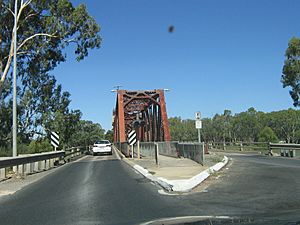Paringa Bridge facts for kids
Quick facts for kids Paringa Bridge |
|
|---|---|
 |
|
| Carries | Barmera railway line Sturt Highway |
| Crosses | Murray River |
| Locale | Paringa, South Australia |
| Maintained by | Department of Planning, Transport & Infrastructure |
| Characteristics | |
| Design | Vertical-lift |
| Total length | 173 metres |
| History | |
| Opened | 31 January 1927 |
| Closed | 7 March 1984 (rail only) |
The Paringa Bridge is a special bridge in Paringa, South Australia. It carries the busy Sturt Highway over the Murray River. For many years, it also carried the Barmera railway line. This made it a unique bridge that handled both cars and trains at the same time!
Contents
About the Paringa Bridge
The Paringa Bridge is 173 metres long. It has a special section called a vertical-lift span. This part of the bridge can actually move up and down! It is 78 feet (24 m) long and can rise 30 feet (9.1 m) high in just one and a half minutes. This allows boats and ships to pass underneath easily.
How the Bridge Was Built
The bridge was designed by the South Australian Railways (SAR). It was built by a company called Perry Engineering from Adelaide. The Paringa Bridge officially opened on 31 January 1927. When it was first built, it was a road-rail bridge. This means both the Sturt Highway and the Barmera railway line shared the same path across the bridge.
Changes Over Time
Later on, extra lanes were added to the sides of the bridge. This helped to separate the road traffic from the trains. The very last train crossed the bridge on 21 May 1982. The railway line was officially closed a bit later, on 7 March 1984. In 1986, the train tracks were removed. The space where the tracks used to be was then turned into a path for people to walk and cycle.
Daily Operations
The vertical-lift part of the bridge still opens twice every day. This allows river boats and other water traffic to pass safely along the Murray River.
A Special Landmark
The Paringa Bridge is an important part of history. Because of its unique design and long service, it was listed as a State Heritage Place. This happened on 29 June 1989, meaning it is protected for future generations to enjoy.

